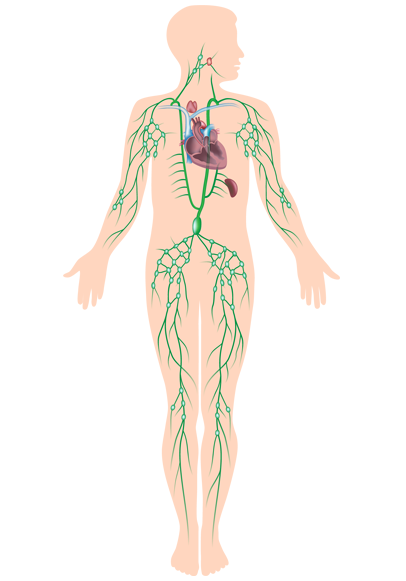Lymphatic System
Lymphatic System is an organ system consisting of lymph vessels, lymph nodes, and particular organs associated with the movement of a clear fluid (Lymph) from the Body towards Heart . It is a part of the Circulatory System. It is closely related to the Immune System too.
read moreLymphatic System
STRUCTURE :
Lymphatic System is made up of Lymphoid Tissue. It is present in many organs and manifests as primary and secondary Lymphoid Organs and associated Lymphatics.
■ Primary Lymphoid Organs : These organs include Bone Marrow and Thymus. Primary Lymphoid Organs produce lymphocytes by the division of Immature Progenitor Cells. Bone Marrow usually produces, while Thymus filters Lymphocytes types. They are also called Central Lymphoid Organs.
■ Secondary Lymphoid Organs : Lymph Nodes and Lymph Follicles constitute Secondary Lymphoid Organs. They are the site where Lymphocytes are present and stored in inactive but mature form. Thus it is also a place for initiating an immune response as antigens are presented to these lymphocytes here. Lymphocytes after their activation proliferate and increase in number and affinity for that antigen. They are also called Peripheral Lymphoid Organs. They are further described as follows :
-
Lymphoid Follicles : These are collection of lymphoid tissue present in association with Mucus Membranes mostly. These follicles may be present as small swollen masses. Their examples are Peyer’s Patches inside intestine, Tonsils at the back of the Tongue, Spleen and skin etc.
-
Lymph Nodes : Lymph Nodes are small bean shaped swellings present along the Lymph Vessels. These small organs contain Lymphoid Tissue. Inside they are divided into Cortex and Medulla. Cortex is the outer part containing Lymphoid Tissue. Inner portion is called Medulla. Cortex covers Medulla on all sides except the depression known as Hilum. This depression gives it a bean shaped structure.
Afferent Lymph Vessels bring Lymph inside Lymph node from different sides other than Hilum. Lymph travels all way inside from Cortex to Medulla and reaches Hilum. Efferent Vessels take Lymph away and arise from the Hilum.
Lymph nodes vary in size and number at different places in the Body. They are most numerous in the Neck, Armpit, Chest, Pelvis and Groin region. They are also found associated with the blood vessels inside intestines and are involved in absorption of digested material. Size of a node increases much in size after it an antigen is presented to it, which activates its Lymphocytes.
■ Lymphatics : These are small vessels which carry Lymph from the Body to the Heart. They are also called Lymphatic Channels. They are usually not visible like Blood Vessels. Inside intestines their special form Lacteals exist.
FUNCTION :
- As blood flows through capillaries inside tissues it usually loses some of its plasma fluid through spaces between capillaries to the surrounding tissues. Thus it forms Interstitial Fluid. Overall our body processes 20 litres of plasma per day via circulatory system however only 17 litres of this plasma is circulated by Blood Vessels. The rest of 3 litres collects in tissues in form of the Interstitial Fluid and is circulated back to the Heart by the help of Lymphatic System. As interstitial fluid enters slowly inside Lymphatic Vessels it is now called Lymph. It is moved slowly towards the bigger Lymphatics. Lymph from the whole body collects inside Right and Left Thoracic Ducts which are large Lymphatic Vessels in the Thoracoabdominal region. These Ducts pour their Lymph into the large Veins around the Heart.
- Lacteals are presents inside the the walls of the Intestines. They are modified form of Lymphatic Vessels and absorb fats and Chyle (emulsified fats and Lymph). These substances travel upwards and reach Thoracic Ducts. They are slowly poured into the Venous Circulation from here. Hence they help in absorption of fats in the food.
- After White Blood Cells are formed inside the Bones they travel to and fro the Lymphatics. They are first sent to the Thymus where they are filtered and those Lymphocytes which are formed against the Body’s own antigens are destroyed. Rest of them are passed onto other Lymphoid Tissues where they are stored for use later.
- Antigen Presenting Cells are those which take up antigens of the foreign pathogen present inside the body and take them to White Blood Cells (Lymphocytes). These Cells thus inform and activate the Lymphocytes against the foreign threat. Hence Immune System is activated and responds to the pathogenic situation. These Antigen Presenting Cells (APCs) also travel through the Lymphatics and present antigens to the Lymphocytes inside the Lymph Nodes.
CLINICAL SIGNIFICANCE :
- Lymphatic System is very important in the study, diagnosis and treatment of the various forms of Cancers. Lymphatics are largely the pathways across which cancer cells travel. They usually accumulate inside the Lymph Nodes adjacent to the cancerous tissue after detaching from it. Here they may be destroyed or form another secondary tumor if survive.
- Cancers can also arise within the Lymphatic System. For e.g. Hodgkin's Lymphoma, Non-Hodgkin’s Lymphoma.
- Lymph Nodes usually swell in various infections hence can be diagnostic for undergoing pathogenesis.
- Some parasites also affect Lymphatic System and result in its inflammation and blockage. For e.g. Filariasis.
Report Error



